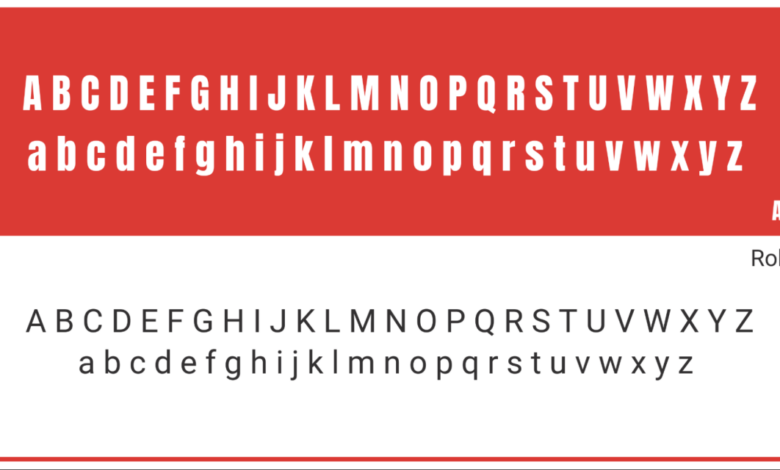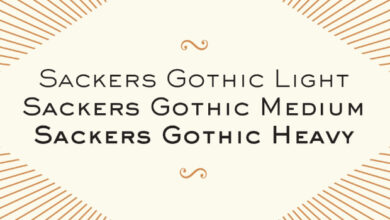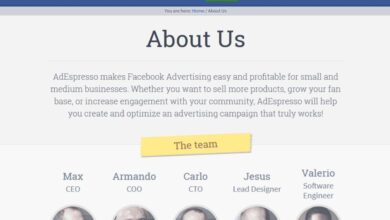
Best Google Fonts for Logos
Best Google Fonts for Logos: Finding the perfect font for your logo is crucial – it’s the visual cornerstone of your brand identity. This isn’t just about aesthetics; it’s about choosing a typeface that’s memorable, readable, and perfectly reflects your brand’s personality. We’ll dive into the world of Google Fonts, exploring different categories, pairing strategies, and practical considerations to help you make the best choice for your next logo design.
From the elegant curves of a serif font to the clean lines of a sans-serif, the right Google Font can make or break your logo. We’ll examine how font weight, style, and even the target audience influence your decision, providing real-world examples and practical tips to guide you through the process. Get ready to discover the fonts that will elevate your logo from good to unforgettable!
Font Characteristics for Logo Design

Source: graphicpie.com
Choosing the right font for your logo is crucial; it’s the visual cornerstone of your brand identity. A well-chosen font can instantly communicate your brand’s personality and values, while a poor choice can undermine your entire message. Consider this your guide to selecting the perfect typeface for your logo.
Ideal Font Characteristics for Logos
A successful logo font needs several key characteristics. Readability is paramount; even at small sizes, your logo should be easily decipherable. Scalability ensures your logo looks crisp and clear across various applications, from business cards to billboards. Memorability is essential; a unique and memorable font helps your logo stand out and become instantly recognizable. Finally, the font should be versatile enough to work across different media and color palettes without losing its impact.
Consider the overall aesthetic and ensure the font complements the logo’s design elements and brand identity.
Impact of Font Weight on Logo Perception
Different font weights significantly influence how your logo is perceived. Light weights often convey a sense of elegance and minimalism, suitable for brands aiming for a sophisticated image. Regular weights offer a balanced and approachable feel, ideal for most brands. Bold weights communicate strength, confidence, and authority, often preferred by companies wanting to project power. The choice of weight should align directly with the desired brand personality.
For example, a technology company might opt for a bold font to project innovation and leadership, while a boutique hotel might choose a lighter weight to convey luxury and refinement.
Examples of Fonts for Different Brand Personalities, Best google fonts for logos
The right font can dramatically shape how your brand is perceived. Below is a table showcasing fonts that effectively convey professionalism, playfulness, and luxury.
| Font Name | Style | Example Use Case | Visual Description |
|---|---|---|---|
| Roboto | Sans-serif, clean | Technology company, modern app | Geometric, simple, and highly legible with a neutral, modern feel. Think of its use in Google’s branding – clean lines and easily scalable. |
| Playfair Display | Serif, elegant | High-end fashion brand, luxury hotel | Classic serif typeface with elegant flourishes. It possesses a timeless quality that exudes sophistication and refinement. |
| Poppins | Sans-serif, geometric | Start-up, contemporary brand | Modern and versatile sans-serif font with a slightly rounded geometric feel, conveying approachability and modernity. |
| Pacifico | Script, hand-drawn | Coffee shop, children’s brand | A casual script font that gives a hand-drawn, friendly, and approachable feel, perfect for brands targeting a younger demographic or aiming for a whimsical vibe. |
Google Fonts Categorization for Logos
Choosing the right Google Font for your logo is crucial; it significantly impacts brand recognition and overall aesthetic appeal. The vast library of Google Fonts can feel overwhelming, but understanding how fonts are categorized and their respective strengths and weaknesses can streamline your selection process. This post breaks down Google Fonts into categories most relevant for logo design, highlighting their suitability and providing examples.
Serif Fonts for Logos
Serif fonts, characterized by small decorative strokes (serifs) at the ends of letterforms, often convey a sense of tradition, elegance, and sophistication. They can be excellent choices for logos targeting a classic or established brand image. However, their intricate detail can sometimes appear cluttered at smaller sizes, limiting their versatility in various applications.
- Playfair Display: A transitional serif with high contrast and elegant curves, perfect for logos requiring a touch of classic sophistication. Imagine it used for a high-end boutique or a luxury brand.
- Merriweather: A highly legible serif with a friendly, approachable feel. Its versatility makes it suitable for logos that need to be both sophisticated and easily readable, perhaps for a publishing house or a law firm.
- Lora: A refined and elegant serif with a slightly modern feel, offering a balance between classic elegance and contemporary aesthetics. This could work well for a coffee shop or a book store logo.
Sans-Serif Fonts for Logos
Sans-serif fonts, lacking the decorative serifs, project a modern, clean, and minimalist aesthetic. They are incredibly versatile and widely used for logos across various industries, offering excellent readability and scalability. However, the lack of serifs can sometimes result in a less distinctive or memorable logo if not carefully chosen.
- Roboto: A geometric sans-serif known for its clarity and readability. Its clean lines make it a popular choice for tech companies or brands aiming for a modern, straightforward image. Think of a minimalist app logo.
- Open Sans: A highly versatile and legible sans-serif, offering a friendly and approachable feel. Its versatility makes it suitable for a wide range of applications, including logos for businesses aiming for broad appeal.
- Montserrat: A geometric sans-serif with a slightly more distinctive and modern feel than Roboto. Its strong, confident forms make it suitable for logos requiring a bolder statement, such as a fitness brand or a financial institution.
Script Fonts for Logos
Script fonts mimic handwriting, often conveying a sense of personality, elegance, and artistry. They are particularly effective for logos targeting brands with a feminine, luxurious, or handcrafted feel. However, they can be less legible than other font types, and their use should be carefully considered to ensure readability across various sizes and applications. Overuse can lead to a cluttered and unprofessional appearance.
- Great Vibes: A casual script font with a flowing, handwritten appearance, suitable for logos that need a friendly, approachable, and slightly whimsical feel. Imagine a bakery or a craft shop.
- Dancing Script: A more elegant and formal script font with a refined appearance, suitable for logos that require a touch of sophistication and flair, such as a wedding planner or a high-end fashion brand.
- Pacifico: A playful and casual script font with a slightly more informal appearance. It is suitable for logos requiring a relaxed and friendly vibe, such as a coffee shop or a children’s brand.
Display Fonts for Logos
Display fonts are often highly stylized and decorative, making a strong visual statement. They are best used as accent elements within a logo, rather than for the entire logotype, as their intricate details can often hinder readability. They are best suited for short text or single words.
- Lobster: A playful and slightly quirky display font with a hand-drawn feel. Its distinctive style makes it suitable for logos needing a unique and memorable visual element.
- Anton: A bold and condensed sans-serif display font that projects a strong and confident image. It’s well-suited for short slogans or brand names needing a powerful visual impact.
- Bangers: A bold and playful display font with a slightly retro feel. It’s suitable for logos aiming for a fun, energetic, and attention-grabbing aesthetic.
Font Pairing Strategies for Logos
Choosing the right font pairing is crucial for creating a logo that’s both memorable and effective. A successful pairing enhances readability, conveys the brand’s personality, and ensures visual harmony. Poor font choices, on the other hand, can lead to a cluttered and confusing logo that fails to make an impact. This section explores effective strategies for pairing Google Fonts to achieve a visually appealing and balanced logo.Font Pairing Strategies for effective Logo Design involve understanding the interplay between different typeface styles and their visual weight.
The goal is to create a harmonious relationship, not a clash. Consider factors like the font’s style (serif, sans-serif, script), weight (light, regular, bold), and x-height (the height of lowercase letters).
Font Hierarchy in Logo Design
Font hierarchy establishes a clear visual order within a logo. It guides the viewer’s eye to the most important elements first. Typically, a logo uses one primary font for the main brand name and a secondary font for supplementary text (like a tagline). The primary font should be bold and easily readable, while the secondary font should complement it without competing for attention.
This hierarchy ensures that the brand name remains prominent and easily identifiable. For instance, a logo might use a strong, bold sans-serif font for the company name and a lighter, more delicate serif font for a short tagline.
Logo Concepts with Google Font Pairings
Below are three different logo concepts demonstrating effective font pairings from Google Fonts, along with explanations of the design choices.
Logo Concept 1: Modern Tech StartupThis logo uses “Roboto” (sans-serif) as the primary font for the company name “InnovateTech.” Roboto’s clean, geometric forms convey modernity and technological sophistication. The secondary font, “Lato” (sans-serif), is used for the tagline, “Solutions for Tomorrow.” Lato’s slightly rounded forms soften Roboto’s starkness, adding a touch of approachability. The Roboto font is in bold, while Lato is in a lighter weight, establishing a clear visual hierarchy.
The color scheme uses a deep blue for the primary text and a lighter grey for the tagline, reinforcing the professional and trustworthy image. The overall effect is a clean, modern, and easily readable logo suitable for a tech startup.
Logo Concept 2: Rustic Coffee ShopThis logo features “Playfair Display” (serif) as the primary font for the coffee shop name, “The Daily Grind.” Playfair Display’s elegant serifs and high contrast create a classic and sophisticated feel, suitable for a coffee shop aiming for a premium, rustic atmosphere. The secondary font, “Open Sans” (sans-serif), is used for the tagline, “Your Daily Dose of Happiness.” Open Sans’s neutral style complements Playfair Display without overpowering it.
The Playfair Display is used in a slightly condensed style to maintain elegance while fitting within the logo’s space constraints. The color palette employs earthy tones, such as brown and beige, to reinforce the rustic theme. The contrast between the elegant serif and the clean sans-serif creates a balanced and visually appealing logo.
Logo Concept 3: Playful Children’s BrandThis logo utilizes “Pacifico” (script) as the primary font for the brand name, “Little Wonders.” Pacifico’s hand-drawn style creates a friendly and playful atmosphere, perfect for a children’s brand. The secondary font, “Raleway” (sans-serif), is used for the tagline, “Inspiring Young Minds.” Raleway’s clean lines provide a contrast to Pacifico’s script, making the tagline easy to read. Pacifico’s playful nature is balanced by Raleway’s clean simplicity, preventing the logo from feeling too cluttered.
A vibrant color palette, featuring bright and cheerful colors like pastel pink and light blue, further enhances the playful feel. The logo’s overall design is whimsical yet legible, appealing to both children and parents.
Considering Context and Brand Identity: Best Google Fonts For Logos
Choosing the right Google Font for a logo isn’t just about aesthetics; it’s about aligning the typeface with the brand’s overall identity and communicating its core values effectively to the target audience. The font you select should subtly (or sometimes boldly) convey the brand’s personality and resonate with its intended consumers. A mismatch can lead to confusion and dilute the brand’s message.The selection process should be deeply informed by the brand’s key characteristics.
Choosing the best Google Fonts for logos is crucial for brand recognition; the right font can make all the difference. To really get your logo out there, though, you need a strong online presence, which is why learning about video marketing is key – check out this awesome guide on getting it on with youtube to boost your brand visibility.
Once your YouTube channel is rocking, remember that consistent font usage across all your platforms, including your logo, reinforces your brand identity.
Understanding the target audience, the brand’s mission statement, and its core values are crucial steps in this process. These elements work together to define the overall brand personality, which directly impacts the appropriate font choice. For example, a playful font might suit a children’s toy brand, while a more serious and sophisticated typeface would be better suited for a law firm.
Brand Elements and Font Selection
The relationship between brand elements and font selection is multifaceted. Consider a company aiming for a modern and minimalist aesthetic. A clean sans-serif font like Roboto or Open Sans would perfectly complement this image. These fonts project a sense of simplicity, efficiency, and modernity, which aligns seamlessly with the brand’s desired identity. Conversely, a brand aiming for a traditional and established feel might opt for a serif font like Playfair Display or Merriweather, evoking feelings of heritage and trustworthiness.
The font choice acts as a visual representation of the brand’s promise and personality.
Demographic Considerations and Font Choices
Different demographics respond differently to various font styles. A logo targeting young adults might utilize a more playful, unconventional font, perhaps something with a slightly informal or hand-drawn feel like Dancing Script or Patrick Hand. These fonts often communicate youthfulness, energy, and creativity, which resonates well with younger audiences. In contrast, a logo designed for professionals often benefits from a more classic and refined font.
Fonts like Lato or Montserrat, with their clean lines and professional appearance, convey sophistication, reliability, and trustworthiness—attributes highly valued by professional audiences. The contrast highlights how a careful consideration of the target audience informs the font selection, ultimately maximizing the logo’s impact.
Practical Considerations and Limitations
Choosing a Google Font for your logo might seem straightforward, especially given the vast and free selection available. However, using these free fonts for professional logo design presents several practical limitations that need careful consideration before committing to a design. While the ease of access and variety are attractive, overlooking these limitations could lead to significant problems down the line.While Google Fonts offer a convenient and cost-effective solution for many design projects, they aren’t always the ideal choice for professional logo creation.
The inherent limitations primarily revolve around licensing, potential conflicts with other branding elements, and the overall longevity and adaptability of the font choice.
Licensing and Usage Rights
Google Fonts operate under various open-source licenses, primarily the SIL Open Font License (OFL). Understanding these licenses is crucial. While many allow for commercial use, restrictions often apply. For instance, you can’t simply redistribute the font itself without adhering to the license’s terms. More importantly, simply using a Google Font doesn’t automatically grant you exclusive rights.
Another company could use the same font in their logo, potentially creating confusion or diluting your brand’s visual identity. This lack of exclusivity is a key difference between using a free Google Font and commissioning a custom typeface, which provides unique branding protection.
Factors Beyond Aesthetics in Google Font Selection for Logos
Choosing a logo font requires more than just liking its appearance. Several practical factors must be considered to ensure the logo remains effective and adaptable across various applications and over time.
- Scalability: A logo needs to look good at any size, from a tiny favicon to a large billboard. Some fonts don’t scale well, becoming blurry or losing their legibility at smaller sizes. Consider how the font renders at different resolutions and sizes before settling on a choice.
- Readability: Your logo needs to be easily readable, even at small sizes. Intricate or overly stylized fonts can hinder readability, making your brand name difficult to decipher. Prioritize clear and concise typography.
- Versatility: A well-designed logo should work across various media – print, web, and mobile. Choose a font that adapts well to different contexts and maintains its visual integrity across various platforms.
- Timelessness: Trends in typography change. Select a font that is classic and elegant rather than trendy, ensuring your logo doesn’t look dated quickly. Avoid overly fashionable fonts that might become obsolete within a few years.
- Compatibility: Ensure the chosen font works well with your brand’s color palette and overall visual identity. Consider how it interacts with other design elements in your branding materials.
- Weight and Style Variations: Check if the Google Font offers sufficient weight variations (e.g., thin, regular, bold) and styles (e.g., italic) to support your branding needs across different applications. A limited range of styles can restrict your design flexibility.
Illustrative Examples of Successful Logo Font Choices
Choosing the right font for a logo is crucial; it significantly impacts brand recognition and memorability. A well-chosen font can instantly communicate a brand’s personality and values, while a poor choice can undermine the entire visual identity. Let’s examine three iconic logos to illustrate this point.
Google Logo Font Analysis
The Google logo uses a custom sans-serif typeface, often described as a playful yet professional variation of Catull, a typeface inspired by geometric sans-serif fonts. The font’s rounded terminals and slightly condensed proportions contribute to a feeling of approachability and friendliness, aligning perfectly with Google’s image as a user-friendly tech giant. The vibrant primary colors further enhance this perception.
The font’s clean, simple design ensures high readability across various sizes and applications, contributing significantly to its memorability. The slight variations in letter spacing and the unique “g” further enhance its distinctiveness. The consistent use of this font across all Google platforms has cemented its place in global visual culture.
Coca-Cola Logo Font Analysis
The Coca-Cola logo employs a Spencerian script typeface, a style characterized by its elegant flourishes and flowing curves. This script font, a custom design called Spencerian, evokes a sense of nostalgia, tradition, and even a touch of whimsy. The choice perfectly complements the brand’s long history and its association with happiness and shared moments. While the script style might present readability challenges in smaller sizes, the logo’s iconic status and consistent use ensure immediate recognition.
The unique lettering, combined with the distinctive red and white color scheme, contributes to its enduring memorability and instantly recognizable brand identity. The font’s elegant, almost handwritten quality creates a feeling of personal connection with the brand.
Apple Logo Font Analysis
Apple’s logo uses a clean, minimalist sans-serif typeface, specifically a custom version of a font closely resembling Myriad Pro. This font’s straightforward, modern aesthetic reflects the brand’s focus on simplicity, innovation, and technology. The font’s clear and legible design ensures its readability across diverse applications, from the tiny icon on a phone screen to large-scale billboards. The absence of unnecessary ornamentation aligns with Apple’s design philosophy of sleek minimalism.
The font’s neutrality allows the iconic Apple logo itself (the apple) to be the central visual focus, enhancing its memorability. The consistent use of this font across all Apple products further strengthens brand recognition.
Closure

Source: amazonaws.com
Ultimately, selecting the best Google Font for your logo is a journey of balancing aesthetics with functionality. Consider your brand’s identity, your target audience, and the overall message you want to convey. By carefully considering the factors we’ve discussed – readability, scalability, and brand alignment – you can confidently choose a font that not only looks great but also effectively communicates your brand’s unique story.
So, go forth and create a logo that’s as memorable as it is impactful!
FAQ Guide
Can I use Google Fonts commercially?
Most Google Fonts are open-source and free for commercial use, but always double-check the specific license for each font.
What if my chosen Google Font doesn’t scale well?
Opt for fonts with clean lines and simple designs that maintain readability at various sizes. Test your chosen font at different scales before finalizing your logo.
How do I know if a font is too trendy?
Avoid fonts that are overly stylized or have fleeting trends. Choose a timeless font that will remain relevant for years to come.
Are there any Google Fonts specifically designed for logos?
While no font is exclusively for logos, some fonts, due to their characteristics, are better suited than others. Consider the characteristics discussed in the guide.





